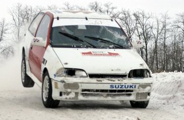springs & swaybars vs springs only (on gravel)
Posted by Iowa999
edit: this is to JVL
Man, you're annoying. And I spend a lot of time with undergrads and on websites, so that says a lot. I asked a question. It might be a question with no simple answer, but I don't have an answer in mind. (Do you really think I'm silly enough to seek affirmation by posting on this website?) I want to know what people think a good ratio of bar to spring would be for gravel. I've seen cars with 50% bars (including L'Estage's) and I've seen cars with very little bar. So I would like to have a discussion of this issue. If you don't want to participate, I'd be fine with that. more edit: I would love to get in touch with ACP, too. I have emailed, but did not get a response. Edited 1 time(s). Last edit at 02/03/2013 08:26PM by Iowa999. |
NoCoast Grant Hughes Super Moderator Location: Whitefish, MT Join Date: 01/11/2006 Age: Midlife Crisis Posts: 6,818 Rally Car: BMW |
|
Creech Scott Creech Senior Moderator Location: Jane, MO Join Date: 12/02/2012 Age: Possibly Wise Posts: 415 Rally Car: Audi 90 Quattro (WIP) |
John - you should know that I've known J.Toby for about 17-odd years now (off and on), and I do not believe it is as you are imagining it here. If he is asking a question, it is legitimate, and it is asked in an effort to actually learn something by the asking. It is NOT an effort to disparage or belittle the work you have done previously, nor yourself. Parfois, on fait pas semblant! I am: I know: I am from: Nobody. Nothing. Nowhere. |
fiasco Andrew Steere Professional Moderator Location: South Central Nude Hamster Join Date: 12/29/2005 Age: Possibly Wise Posts: 2,008 Rally Car: too rich for my blood, share a LeMons car |
|
fiasco Andrew Steere Professional Moderator Location: South Central Nude Hamster Join Date: 12/29/2005 Age: Possibly Wise Posts: 2,008 Rally Car: too rich for my blood, share a LeMons car |
Oh, and if somebody gives you his setup info, I think it's polite and proper to ask permission before posting the setup and/or the source on the interwebz. Not everyone is so "open source" about what they've done to their car, and that's their right (you may think it's stupid and arrogant to play the superiority card, but hey, that's how many egomaniac racer types are).
But yes, there is a difference between the recommendations of somebody who's won many national events (and championships) and somebody's who's placed third in class in a grass-o-cross. Fortunately, Antoine seems to be a nice guy. I don't know him other than to have nodded and said "hi" at events, but don't doubt that he'd help a guy with setup questions. What does he have to lose? Andrew Steere Lyndeborough, NH KB1PJY |
Thanks, Scott. This definitely has nothing to do with John VL. In fact, there's a bit of a funny story here. In his first reply, Antoine L'E said his springrates were 25 kg. Thinking that he was saying 25 kg/mm, I was blown away, because that's 1400 #/inch. The only other measure that I know that involves kg is kg/m, but that would be 14 #/inch, which is what people run on an R/C Evo. So I carefully asked what the rest of the units were. To get me the answer to this, Antoine L'E said that he had to ask someone named John. For a moment, I thought that maybe the person that Antoine L'E asked was John VL and had a brief and somewhat ironic laugh, especially in light of how the last thread I tried here crashed and burned on a disagreement about what units to use for discussion.
In any event, he really did say 140 #/inch, as that is what 25 kg/cm converts to. That seems very soft to me, too, but my experience is that the best drivers in many sports prefer softer springs. (One of the best autocrossers that I know - Sam Strano - runs ridiculously soft springs on his cars, but wins another national championship at least every other year.) And when you add in the swaybars (and note that Antoine L'E's Evo probably weighs only a bit more than 3000#), front and rear single-wheel rates of 250 and 200 #/inch isn't all that low. But all of this is too specific, which might be what's causing the grief. I wish I could say more from experience, but all I can do is drive my car with and without the bars attached, so I'm not comparing the same wheel-rates with and without bars; I'm comparing a low rate without bars to much higher rates with bars. What I really want to learn about are the positives and negatives of the same wheel-rates achieved with and without bars. |
I got a giggle from this, too.
That was my thinking, so I asked. But, as you also said, he's a very nice guy and said "no prob." Edited 1 time(s). Last edit at 02/03/2013 10:49PM by Iowa999. |
mekilljoydammit Senior Moderator Join Date: 09/22/2010 Age: Midlife Crisis Posts: 336 Rally Car: No rally car yet |
|
|
mekilljoydammit Senior Moderator Join Date: 09/22/2010 Age: Midlife Crisis Posts: 336 Rally Car: No rally car yet |
Well, we're looking at one of those reasons why generalities vs. specific situations make a difference, which is why John, in his cranky (and let's say that, in his position, I can see why he'd get cranky over the years and move on with the topic) way, was trying to get the whole picture. I'm an injurneer, and not in a position where thinking shit out on the keyboard takes me away from stuff that would get a car on stage, so I'll noodle a bit.
Let's get more technical, though no numbers because I can't even visualize how all the features would work; I may go try to find patents later. Look at Reiger's site about the features on their top of the line dampers; they have valving that separates ride movements from bump movements, stuff that comes into play at more travel to act as a progressive bumpstop, stuff that senses when weight is off the wheels and reduces the rebound damping to let the suspension move to full droop... all of which means that they take care of a bunch of functions normally done with springs with valving instead. Body roll has extra valving adding onto spring forces, big hits and jumps have the dampers kept from topping out with valving/hydraulic bumpstops instead of spring rate, etc. I know Reiger, EXE-TC, and Bos all have stuff like that working internally, and I'd suspect Ohlins does on some of their top of the line rally stuff as well. But what this means is that unless you're going apples to apples and running the same dampers his rates may not be directly comparable. The Evo X has a lot of very good stuff available and at his level, he's probably running very good stuff. In fact, from googling him and looking at his page, Mr. L'Estage lists EXE-TC as one of his sponsors/supporters/suppliers/whatever. If you're running something else, his setup data probably isn't going to be directly useful. That isn't to say that his data isn't a good datapoint, but even with the extra data I just added it's still only part of the picture, and not really enough to know what's going on there and how to apply it to you. Let's take an educated guess and suggest that the various valving allows him to setup the car such that the roll stiffness is coming from bars too, because the spring rate doesn't have to be high enough to soak up bumps thanks to the dampers. Now, what are you looking at running for dampers? Maybe something where you'd have to increase the spring rate to avoid bottoming out because your dampers aren't as fancy, and thus you wouldn't need sways to get to a given roll resistance? |
Thanks for taking the time to write all that out. It will take a while for me to digest it all, but I can answer your direct question immediately: I was planning to either use the Bilsteins off an MR (with the perches replaced with a sleeve, a la Ground Control) or Bilstein universals in the front (for which my favorite fabricator is making a bracket) and Bilstein ASNs in the rear (since an Evo X is multilink rear).
|
Jay Jay Woodward Godlike Moderator Location: Snohomish, WA Join Date: 12/21/2005 Age: Possibly Wise Posts: 893 Rally Car: '90 Mazdog Frankenprotege |
This is all way too complicated. Go run a section of road with swaybars and then run the same section without. Since traction is more important than body roll, I think you'll find your stage times to be quicker without the bars. And if they aren't, then keep the bars. What matters is how the car goes and if it makes you grin, the rest is just useless gumflapping.
Jay Woodward Snohomish, WA '90 Mazdog Frankenprotege Chronologically, 46... |
Morison Banned Mega Moderator Location: Calgary, AB Join Date: 03/27/2009 Age: Ancient Posts: 1,798 Rally Car: (ex)86 RX-7(built), (ex)2.5RS (bought) |
EXE-TC First Rally: 2001 Driver (7), Co-Driver (44) Drivers (16) Clerk (10), Official (7), Volunteer (4) Cars Built (1), Engines Built (0) Cages Built (0) Last Updated, January 4, 2015 
|
edit: reply to Jay:
I have done that many times over the last six months. I've done every combination of with and without bars ... both attached, front only, rear only, neither. The problem is that removing the bars also drops the single-wheel rate. What I'm asking about is the difference between the same single-wheel rates acheived only by springs vs by a combination of springs and bars. I think that I get what Daniel is saying and it both makes sense and makes me sad that I don't have more money. The idea that good shocks can take the place of the springs (and/or bars), keeping you off the bump-stops while still being compliant, sounds too good to be true, but I'm sure that it's possible ... just beyond my understanding as to how they do it. In the end, I'll probably just take the plunge and try something (by March), just to get the ball rolling, as it were. But this is still "silly season" for me, so I wanted to learn as much as possible before making a choice. Edited 1 time(s). Last edit at 02/04/2013 10:39AM by Iowa999. |
heymagic Banned Junior Moderator Location: La la land Join Date: 01/25/2006 Age: Fossilized Posts: 3,740 Rally Car: Not a Volvo |
|
Sorry, only registered users may post in this forum.
Rally Anarchy © 2014 Corvus Digital –
Part of the AutoShrine Network –
Problems? Send an email to the Webmaster




